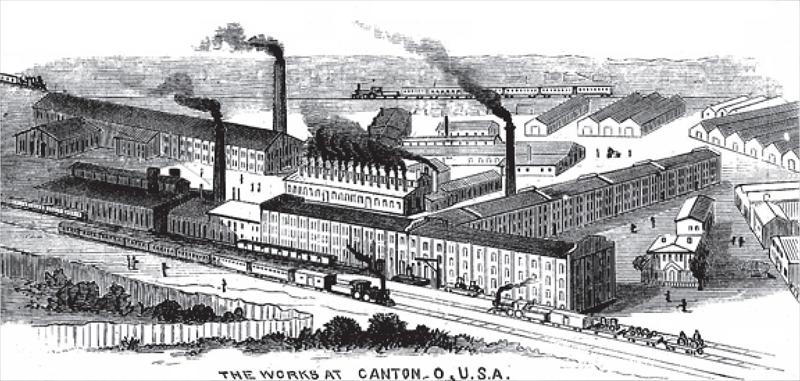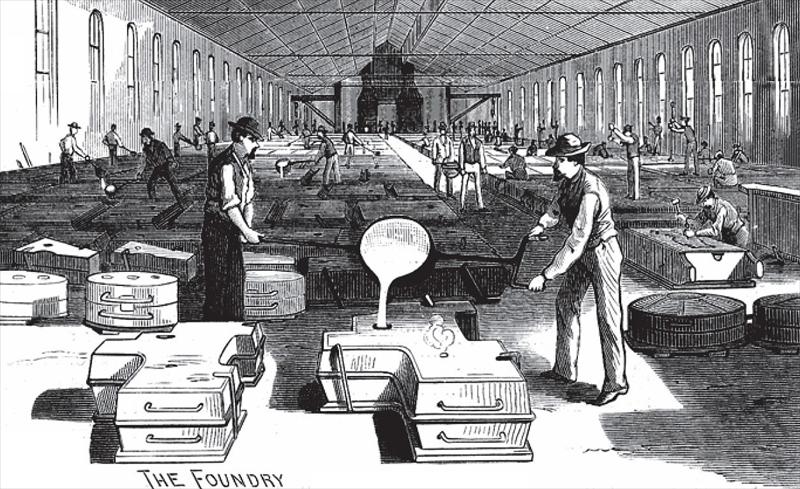|
Title: |
1882 Article-C. Aultman & Co., |
|
Source: |
Scientific American 10 Jun 1882 pg 362 |
|
Insert Date: |
2/28/2012 3:55:33 PM |
HARVESTING AND THRESHING MACHINERY.
The great prominence achieved by representatives of the Buckeye State in national affairs during recent years Is a notable fact, and it may safely be added that the manufacturing interests of the State of Ohio give an eminence in the industrial field equal to that accorded to her by the sisterhood of States in national politics. We have chosen one of the most extensive and successful of these manufactories as the subject for illustration. The well known incorporated company. C. Aultman & Co., of Canton, Ohio, have among their products Buckeye harvesting machines, threshing machines, and portable engines, horse powers, and all the attachments and equipment required to place their machines in the field fully fitted for instant and effective service. No single manufactory in America produces such an array of laborsaving farm machines. These various machines constitute the most efficient equipment yet designed by human skill to aid the farmer in the several processes by which he fits the ripened grain in the field for market. In these extensive works are found a very large number of wood and metal workers, busily engaged, day and night, by steam and hand power, using the swiftest and most exact methods in shaping and fitting crude materials and converting them into the various parts of the grass and grain saving machines that have in late years revolutionized the operations of agriculture. The mowers and reapers constructed previous to 1857, having only one driving wheel and a rigid cutter bar, were of a very limited capacity and utility, and the introduction of two driving wheels and a double hinged, pliable bar marked a new era, popularized these machines, and gave to their manufacture a most powerful impulse.
The radical improvements to which we refer were invented by Messrs. C. Aultman & Co., of Canton, Ohio, and the
machine to which they were applied was called the ''Buckeye.'' The Buckeye was first exhibited to the world at a trial of machines held at Syracuse, N. Y., in 1857, under the auspices of the United States Agricultural Society.
All the manufactories of any consequence in the country were represented. All the machines present had the single wheel and stiff bar. Only the Buckeye moved on two wheels and had the flexible bar. To the latter was awarded the gold medal and all the honors and commendations that it was in the power of the awarding committee to bestow.
From that day to this all farmers have exacted, and all manufacturers have been compelled to supply, machines patterned after the model first made by C. Aultman & Co., and shown by them at Syracuse.
As early as 1863 the Buckeye interest had assumed such proportions that it was deemed best to establish another manufactory at Akron, some twenty miles north of Canton, and to divide the selling territory between the two establishments. The management of the Akron branch has been so vigorous and aggressive that, coupled with the excellent territory which fell to its share, including some of the rapidly developing States of the great West, it bids fair before many years to rival the parent house in the volume of its business.
The superintendent of works at Canton is Mr. Jacob Miller, who has for many years occupied this responsible position. The president of the board of directors is Mr. Lewis Miller, of Akron, who is also superintendent of the Buckeye Works at Akron. It will interest our readers to know that these brothers, who in their youth had a distinguished part in the invention of the Buckeye, still retain actual control of its vast manufacturing interests. Mr. Henry C. Fogle, the secretary and treasurer of the house, has bud the management of its financial affairs for the last eight years, during which its business has been not only most successful, but very largely extended. Mr. Cornelius Aultman, who was prominently identified with the business in the beginning and for a number of years thereafter, and from whom the corporation takes its name, still resides in Canton. He is largely interested in the works, but has not actively participated in the business for some years. It thus appears that the genius, which designed and contrived an implement of such enormous importance as the reaper of the present day has reaped a suitable reward.
No single fact better illustrates at once the standard character of these machines and the continuous development of our agricultural interests than the history of such a house. Some persons have supposed that in view of the tens of thousands of these machines issued from year to year the wants of the farmers would by-and by be measurably supplied and that the demand would be comparatively diminished.
The contrary, however, is true. Tear after year, with rarely an exception, additional room is required and new facilities are brought into requisition. Invention and experiment, in the effort to place the greatest results within the scope of the farmer, are constantly adding and improving. The latest addition, and one that promises to outstrip every other labor-saving farm machine in utility and popularity, is the Buckeye twine self-binder. This machine is drawn by three horses and operated by one person, cutting, raking, and securely binding with twine from fifteen to twenty acres of grain daily, and doing the work far more neatly, whether the grain is standing or tangled, than it can be done by any other process. With such a machine nearly all the expense and drudgery of harvest are spared to the farmer and his wife. Agriculture can scarcely ask invention to go a step further. This machine differs from all other binding machines in essential particulars, and many of its more important features are secured to the company by their own or by acquired patents.
In the manufacture of threshing machines and portable engines Messrs. C. Aultman & Co. have gained unrivaled distinction. The thresher made by C. Aultman & Co., named the "New Model," heads the list of machines of that class, having as special merits solidity, very large capacity, and thorough separation. During thirty years the demand made upon C. Aultman & Co. for this class of machines has been increasing from year to year. Their threshers are adapted to the thorough separation of all grains and of the smallest seeds; and they play a conspicuous part in agricultural industry in the wheat prairies of the West, the rice plantations of Louisiana, and the steppes of Eastern Europe.
"The Canton Monitor " farm engine is the latest addition to the products of this great establishment. This is a safe, simple, and powerful motor, which is within the reach of every thrifty farmer, and perfectly easy to operate.
That steam is destined to play a conspicuous and most labor saving part in the conduct of all farm operations requiring power is a fact that has never been so conclusively demonstrated as by the history of the "Canton Monitor." Its sizes have been multiplied and its annual product has been doubled, trebled, and quadrupled, and yet there is no abatement, in the increase of orders from year to year.
Although C. Aultman & Co. already construct more than double the number of agricultural engines made by any other house, it would seem that this department of their business was only in its infancy.
The New Model threshers are made in four sizes, and the Monitor engines in six sizes, ranging from six to twenty horse power. Both of these machines differ radically from any of the antiquated patterns. Although made by one of the oldest houses in the business, no merit Is or can be claimed by reason of the antiquity of their products. On the contrary, they seek to embody all that is newest, safest, and best within the reach of human skill, invention, and abundant resources. In this field the "Monitor ' road engine, which is shown in our illustrations, is an extraordinary exemplification of advanced attainment in this department. This engine is not only adapted to all agricultural operations requiring power, furnishing that power with the smallest possible expense, but is self-propelling, and very simple in construction and manipulation. And in these days when fatal boiler explosions are so apt to find a place in nearly every day's telegraphic summary of current events, this company may justly felicitate itself that not one such tragedy, or even a personal injury, has been caused by its machines.
In the competitive field the machines made by C. Aultman & Co. have been very successful. The highest honors have been awarded to them at all the great world's fairs. Twenty one gold medals during the past three years signalize as many victories in the fields contested by the leading machines in the world. This great business has taken root in nearly every grain-growing region, including North and South Africa, New Zealand, Romania, and all European nations. "We understand that the company does not consign machines to foreign countries, hut delivers to actual purchasers on shipboard at New York. Shipments of machines were lately made to St. Petersburg, Russia, and Leghorn, Italy. It is curious to note that in three or four European countries leading manufacturers have engaged in producing exact copies of both the grass and grain cutting and the threshing machines made by C. Aultman & Co. While this fact is highly creditable to American skill, it has its vexations to the American manufacturer who has to enter the competitive field against copies of his own products; and who, besides, in all countries beyond the English Channel does so under not a little dead weight in the shape of government duty.
Article courtesy of Brian Szafranski |
|
 C. Aultman & Co., Factory View
C. Aultman & Co., Factory View
 C. Aultman & Co., The Foundry
C. Aultman & Co., The Foundry
 C. Aultman & Co., The Blacksmith Shop
C. Aultman & Co., The Blacksmith Shop
|
|